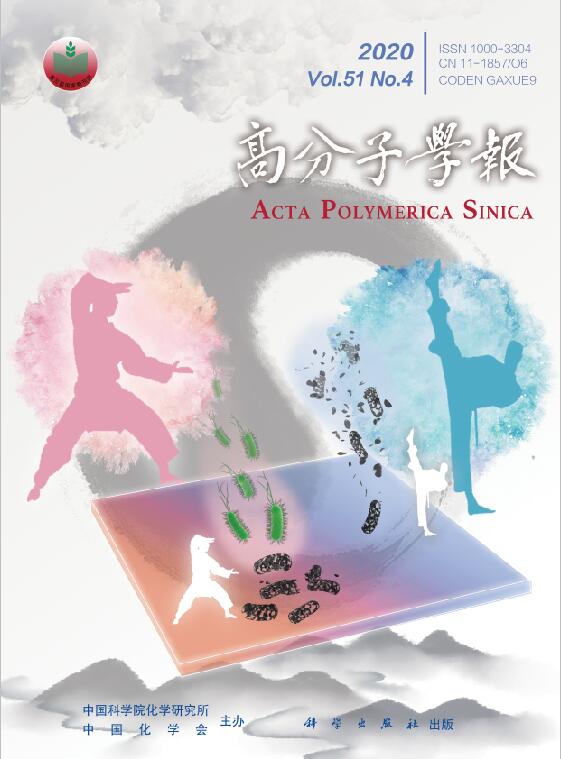1966 Volume 8 Issue 2
1966, 8(2): 59-67
Abstract:
Through the study of the copolymerization of AN and MMA in bulk and in solution of N,N-dimethylformamide,dioxane,benzene,cydohexane,methanol and water,the fol-lowing results have been obtained:1.In solution precipitation copolymerization,it has been proved that solvents do influence the monomer reactivity ratios for certain monomer pairs.2.The copolymer composition curves and the monomer reactivity ratios of such co-polymerization system in different solvents were obtained.It has been proved that the result of the copolymerization of AN and MMA in water obtained by Sadao Yuguchi[6] was not correct.3.According to the above experimental results.we incline to believe that the change of the copolymer composition in precipitation copolymerization seems to be due to the difference between the effective composition of the reacting monomers in the reaction site and the average composition of the monomer in the system.The effective composition of the reacting monomers then would be reasonably assumed to relate both with the dif-ference between the polarities of the two monomers and witll the difference between the polarities of the liquid medium and the solid copolymer.4.In precipitation copolymerization,the concentration of monomer also influences the copolymer composition in certain cases.
Through the study of the copolymerization of AN and MMA in bulk and in solution of N,N-dimethylformamide,dioxane,benzene,cydohexane,methanol and water,the fol-lowing results have been obtained:1.In solution precipitation copolymerization,it has been proved that solvents do influence the monomer reactivity ratios for certain monomer pairs.2.The copolymer composition curves and the monomer reactivity ratios of such co-polymerization system in different solvents were obtained.It has been proved that the result of the copolymerization of AN and MMA in water obtained by Sadao Yuguchi[6] was not correct.3.According to the above experimental results.we incline to believe that the change of the copolymer composition in precipitation copolymerization seems to be due to the difference between the effective composition of the reacting monomers in the reaction site and the average composition of the monomer in the system.The effective composition of the reacting monomers then would be reasonably assumed to relate both with the dif-ference between the polarities of the two monomers and witll the difference between the polarities of the liquid medium and the solid copolymer.4.In precipitation copolymerization,the concentration of monomer also influences the copolymer composition in certain cases.
1966, 8(2): 68-73
Abstract:
The dynamic mechanical properties of polyethylerie terephthalate(PET)monofilament samples with different crystallinity and draw ratio were determined over 100 t0 430°K using the vibrating reed method.In this temperature range two internal friction peaks were observed at 243°K(βc)and 354--383°K(αa).The βc and αa peaks were shown to be influenced by the variation of crystallinity. From the view point of Takayanagi’s mechanical model of crystalline polymers,the β absorption may be attributed to the local twisting motion of the molecular chains in the frozen noncrystalline phase and in the de-fective region within the crystalline phase,and the αa absorption to the translational mo-tion of the segments in the noncrystalline region.The temperature of the αa peak increa3es with increasing draw ratio,while the βc peak remains unchanged.This suggests that the stretching of PET fibre would mainly change the interchain interactions in the noncrystalline region.Takayanagi’s method of determining the crystallinity of PET samples from the loss moduli of βc and αa peaks was confirmed for the fibre samples.
The dynamic mechanical properties of polyethylerie terephthalate(PET)monofilament samples with different crystallinity and draw ratio were determined over 100 t0 430°K using the vibrating reed method.In this temperature range two internal friction peaks were observed at 243°K(βc)and 354--383°K(αa).The βc and αa peaks were shown to be influenced by the variation of crystallinity. From the view point of Takayanagi’s mechanical model of crystalline polymers,the β absorption may be attributed to the local twisting motion of the molecular chains in the frozen noncrystalline phase and in the de-fective region within the crystalline phase,and the αa absorption to the translational mo-tion of the segments in the noncrystalline region.The temperature of the αa peak increa3es with increasing draw ratio,while the βc peak remains unchanged.This suggests that the stretching of PET fibre would mainly change the interchain interactions in the noncrystalline region.Takayanagi’s method of determining the crystallinity of PET samples from the loss moduli of βc and αa peaks was confirmed for the fibre samples.
1966, 8(2): 74-78
Abstract:
A modified method for the carboxyl end group titration of polyethylene terephthalate is presented. The main features of the method are: i) the use of a mixed solvent consisting of phenolchloroform 2:3 V/V to dissolve the polymer sample at 80-100℃ within 2-10 minutes to minimize the error due to thermal degradation of the polymer; ii) direct titration at room temperature; iii) the choice of a suitable indicator, tetrabromo-phenol blue, to give a very sharp end point; iv) the use of a benzyl alcohol solution of potassium hydroxide as titrant for good miscibility with the solution being titrated.
A modified method for the carboxyl end group titration of polyethylene terephthalate is presented. The main features of the method are: i) the use of a mixed solvent consisting of phenolchloroform 2:3 V/V to dissolve the polymer sample at 80-100℃ within 2-10 minutes to minimize the error due to thermal degradation of the polymer; ii) direct titration at room temperature; iii) the choice of a suitable indicator, tetrabromo-phenol blue, to give a very sharp end point; iv) the use of a benzyl alcohol solution of potassium hydroxide as titrant for good miscibility with the solution being titrated.

 Login In
Login In


